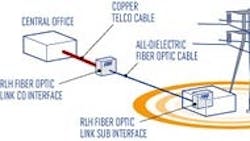Power Over Fiber Shines at Voltage Isolation
A low-level power transmission system based on laser light conducted through fiber optics promises to reduce the risk of interfacing to physical communications channels on the electrical grid. The system, available now and referred to as power over fiber (PoF) by developer RLH Industries (RLH), provides practically infinite voltage isolation capability between a central office in a telecom network, and a high-voltage transformer substation (see Figure 1). According to Jim Furey, Senior Design Engineer for RLH, this increases the protection from hazards associated with ground-potential rise (GPR), which is common to high-voltage zones such as those surrounding power transmission equipment.
Utilities may lease communications lanes on their infrastructures to communications providers, as well as for their own system-management functions, such as supervisory control and data acquisition (SCADA). It is often necessary to interface such grid-based networks with conventional telecom networks. In cases where conventional ac power is unavailable, and options such as solar or wind power are not practical, this could mean running copper data lines directly to substation equipment. However, such installations are particularly prone to GPR hazards.
To preclude these hazards, the PoF system enables the copper-based data link from the telecom office to terminate into a remote fiber-optic modem. This modem then receives power (and sends and receives data) at a safe distance from the substation via optical fibers (see Figure 2). The all-dielectric nature of these optical fibers provides an electrical isolation across their entire length (unlike galvanic isolation, which is restricted to the insulation barriers within a transformer).
The basic PoF system consists of the Tx unit (see Figure 3), located at the substation, and the Rx unit (see Figure 4), located at the remote fiber-copper interface. The two units are linked by three optical fibers. Two fibers transfer the power, with each fiber forming a single power channel for each of the two continuous-wave 830-nm laser diodes in the Tx unit. The third fiber transfers a power-integrity feedback signal from a conventional LED in the Rx unit to a conventional optical receiver in the Tx unit.
According to Furey, the PoF’s energy-transfer efficiency is low because the technology is new, and the main purpose is safety, not performance. The lasers in the Tx unit consume about 48 W in order to deliver about 720 mW at the Rx unit. While power losses increase with fiber length, useful power is still transmitted at the maximum recommended fiber length of 1500 feet.
Furey also states that the lasers have a narrow operating temperature range that requires both active heating and cooling systems onboard the Tx unit. Therefore, the ambient system operating temperature for the Tx unit is from 0°C to 35°C. A more robust version with an ambient operating temperature range of -20°C to +55°C is under development.
Furey states that each of the two energy-carrying optical fibers feeds a respective photovoltaic power converter (PPC) in the Rx unit that produces an output of 12 V. The two receivers are tied in series to generate 24 V at the output. The outputs of several Rx units can also be tied in series or parallel to produce even greater output voltages or currents, respectively.
RLH recently filed the patent for PoF technology, and four evaluation units have been successfully deployed and in service for over a month. According to Furey, the primary application is for powering RLH’s fiber-optic telephone cards that require low power in remote locations without access to grid or portable power. It is certainly interesting to note a certain parallel in history. Specifically, after Bell Labs invented the transistor, it envisioned the sole application of this device as a replacement for the mechanical relays in automated switchboards, to be used exclusively in their own telephone network.
For more information on PoF technology, as well as utility-scale high-voltage isolation, please visit the RLH Industries web site.
